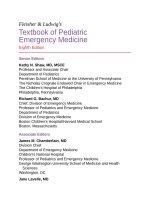Pediatric emergency medicine trisk 0216 0216
Bạn đang xem bản rút gọn của tài liệu. Xem và tải ngay bản đầy đủ của tài liệu tại đây (100.13 KB, 1 trang )
The femoral vein is the easiest central vein to access in the critically ill child
and has less complications. Central venous access provides a more secure route,
allows the capability of monitoring central venous pressure, and allows for blood
sampling. In adults, this route has been shown to provide more rapid onset of
action and higher peak drug levels that theoretically could affect outcome. This
has not been shown to be the case in the pediatric patient. In a child with
uncompensated shock or arrest, IO access is obtained first for rapid initial
resuscitation and central venous access may follow (see Chapter 130 Procedures
).
DRUGS OF RESUSCITATION
Estimating Body Weight
Drug doses, fluid therapy, and equipment size are weight and size based. The 50th
percentile weight from a standardized growth curve can be used to estimate
weight based by known/estimated age. The Broselow tape allows a simple,
accurate method of estimating the weight and drug doses based on the measured
height ( Fig. 9.13 ). In the absence of compelling research, AHA currently
recommends using the actual or tape-based weight for obese children rather than
an ideal weight. Drug doses should never exceed the adult maximum dose. Many
handheld computer programs are available to calculate pediatric resuscitation
drug doses (see Table 9.6 for doses and comments on common resuscitation
medications).









